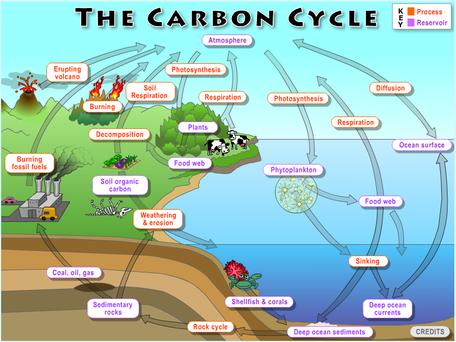The Carbon Cycle (3/20-3/24)
 |
https://d32ogoqmya1dw8.cloudfront.net/images/eslabs/carbon/global_carbon_cycle_1427132279_456.jpgSummary:
This week, we learned about the carbon cycle. The carbon cycle is a process that carbon travels in. There are six reservoirs or places that carbon travels in. Greenhouse gasses like carbon dioxide are dangerous because they are in our atmosphere and are causing the planet to become warmer. In other words, greenhouse gasses create an extra layer (like a blanket) in the atmosphere. This is because humans have burned so much fuel that there is about 30% more carbon dioxide than there was about 150 years ago. On the other hand, without greenhouse gasses, the Earth would be a frozen world.
The six reservoirs are soil, the atmosphere, surface water, deep ocean, marine life, and land plants. 5,000 megatons of carbon are released into the atmosphere as fossils fuels are burned each year. When carbon is in the atmosphere, it is added with two oxygen atoms and becomes a greenhouse gas known as carbon dioxide (H2O.) The small about of carbon dioxide in the atmosphere has increased to about 30% in the past 150 years and makes the planet warmer.
Plants use the sun's energy to produce sugars with photosynthesis. Carbon is one of the building blocks the make up a plant. Plants use carbon, but release it into the atmosphere with respiration as well. Carbon can get to the surface ocean three ways: circulating water from the deep ocean, diffusing from the atmosphere, or by decomposing marine life. The ocean absorbs more carbon dioxide from the atmosphere than the land does, and takes in about 90 gigatons of carbon each year.
For carbon to get to marine life, small marine organisms called phytoplankton take in carbon to make the nutrition that they need through photosynthesis. Then, the phytoplankton is eaten by larger marine life. Carbon is important for marine life, but it can also be harmful. The deep ocean gets carbon from circulation with the surface ocean and dead and decaying marine life. Carbon in the deep ocean usually stays there for a very long time and holds about 65% of the Earths carbon.
The last reservoir is the soil. Carbon is part of the soil called detritus, which is decomposing plants and animals. Soil can also be made of other materials such as clay and sand. Soil stores about 3% of the Earth's carbon. Carbon goes back to the atmosphere from the soil when bacteria and fungi break down the detritus.
My Carbon Cycle Story:
For millions of years, I was underground in fossil fuels. Then, I was released into the atmosphere as humans burn fuels. This made me one of 5,000 megatons of carbon that are released into the atmosphere as fossil fuels are burned each year. When I was in the atmosphere, a carbon atom, I was stuck to two atoms of oxygen into a greenhouse gas called carbon dioxide. A very small amount of the atmosphere is made of carbon dioxide. This has increased 30% in the past 150 years. More carbon dioxide in the atmosphere causes the planet to get warmer, also known as Global Warming.
I was taken from the atmosphere by a plant as it used the sun’s energy to make the nutrition and sugars that it needs. This process is called photosynthesis. Now, I am one of the building blocks that make up a plant. As more carbon like me, is added to the atmosphere, plants can grow faster. Plants not only use carbon dioxide, they also release carbon dioxide with respiration, which happened to me. I was released back into the atmosphere where I was a carbon dioxide atom…
I got to the surface ocean by decomposing marine life. The ocean absorbs more carbon dioxide from the atmosphere than the land. I was one of 90 Gigatons of carbon that are in the surface ocean each year. Cold water absorbs carbon faster than warm water. Small marine organisms called phytoplankton took me in to make the nutrition they needed through photosynthesis. Next, I went to marine life. The phytoplankton was then eaten by a jellyfish, larger marine life. Marine life cannot survive without carbon, but his levels of it that are dissolved in the ocean water can be harmful to marine organisms like algae, mollusks, and corals.
Next, I went to the deep ocean from circulation with the surface ocean and dead and decaying marine life. When I got to the deep ocean, I stayed there for hundreds of years with more than 65% of the Earth’s carbon. Then, I floated to up to the surface ocean and from there I went back into the atmosphere for the third time. From there, another plant needed me for photosynthesis and I traveled to land plants.
Next, I went to the soil. This happened when the plant that I was in died. Now, I am part of the detritus soil, which is decomposing plants and animals. The soil is also made of inorganic plants such as sand, silt, and clay. Soils store about 3% Earth’s carbon. As bacteria and fungi break down the detritus, carbon goes into the atmosphere. After this, I kept moving around for thousands and thousands of years...
SP8: Obtain, evaluate and communicate information:
This week, I used scientific text to find important information, evidence, and ideas about the carbon cycle. We used this information to create a carbon cycle story. This helped me understand and communicate what I learned about the carbon cycle so that I understood how it works and the process carbon goes through. This helped me be more organized and learn with others.
|
Comments
Post a Comment